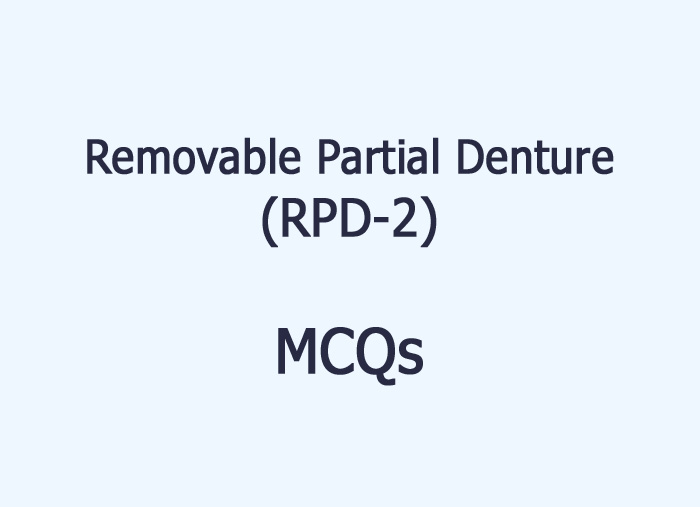- NEED HELP? CALL US NOW
- +919995411505
- [email protected]

a. Spoon shaped, at least1/3 the buccolingual width of the occlusal surface, at least 1mm deep.
b. Flat shaped, at least1/3 the buccolingual width of the occlusal surface, at least 1mm deep.
c. Pear shaped, at least 1/2 the buccolingual width of the occlusal surface, at least 1.5mm deep.
Tear-drop shaped, at least 1/2 the buccolingual width of the occlusal surface, at least 1.5mm deep.d.
Ans: A

2. Direct retainer (clasps)
a. help stabilize the RPD by controlling occlusal movement.
b. help stabilize the RPD by controlling gingival movement
c. may also function as indirect retainers
d. prevent excessive biting forces on the abutment.
Ans: A
Direct retainer: It is that component of a removable partial denture that is used to retain and prevent dislodgment, consisting of a clasp assembly or a precision attachment (GPT 8)
3. A clasp assembly should
a. have a retentive are with adequate length and taper for flexibility
b. have a retentive arm that terminates in an undercut
c. have elements that considered together provide 180 degree encirclement
d. all of above
Ans: D
Clasp Assembly The part of a removable dental prosthesis that acts as a direct retainer and/or stabilizer for a prosthesis by partially encompassing or contacting an abutment tooth. Components of the clasp assembly include the clasp, the reciprocal element, the cingulum, incisal or occlusal rest, and the minor connector.
4. What are the indications for a lingual plate as a major connector for a mandibular RPD?
a. Present high floor of the mouth and facially anterior teeth.
b. Present high lingual frenum and buccally anterior teeth.
c. Present lingual tori and big tongue.
d. High floor of the mouth, high lingual frenum, lingual tori.
Ans :D
Indications :
- high floor of the mouth(< 8 mm)
- prominent lingual frenum
- lingual tori
- the residual ridges in Class I arch have undergone such vertical resorbtion that they will offer only minimal resistance to horizontal rotations of the denture through its bases.
- for using periodontally weakened teeth to furnish support to prosthesis and to help resist horizontal rotation of the distal extension type of denture (act as periodontal splint
5. Anterior-posterior palatal strap especially use is
a. maximum rigidity
b. minimum bulk
c. use in most cases
d. torus palatal
Ans: D
6. Which of the following maxillary major connectors possesses the least strength and rigidity?
a. anterior-posterior palatal strap
b. palatal plate
c. horse -shoe
d. modified palatal strap
Ans: C
U-Shaped Palatal Connector “ Horse Shoe”
- poor connector
- never use unless absolutely necessary
- requires bulk in the rugae area (where the tongue requires freedom) for rigidity
- too flexible
- allows movement at the posterior
- traumatic to the residual ridge
- use only where torus prohibits other connector & extends to the posterior limit of the hard palate
7. Requirements of a Major connector
a. Connects various parts
b. Distributes functional loads to both teeth and mucosa
c. Partial denture acts as one unit
d. Rigidity, non-interference with tissues, minimize food impaction and unobtrusive
Ans: D
8. Maxillary major connector most common use is
a. full palatal strap
b. palatal strap
c. anterior-posterior palatal strap
d. anterior palatal strap
Ans: c
9. shape of occlusal rest in distal extension r.p.d.
a) Deeper and box shaped
b) Shallow and saucer shaped
c) a and b
d) all of above
Ans. B
A rest that is part of a retentive clasp assembly is referred to as a primary rest. Prevent vertical movement of a prosthesis toward the tissues and also help transmit applied forces to the supporting teeth. It should be shallow and saucer shaped, and should function as ball and-socket joint
10. The superior border of mandibular lingual bar major connector should be
a. At least 3mm from the tooth/ tissue junction.
b. At least 2mm from the tooth/tissue junction.
c. As far from gingival margin as possible.
d. At least 3mm above the tooth/ junction.
Ans: A




